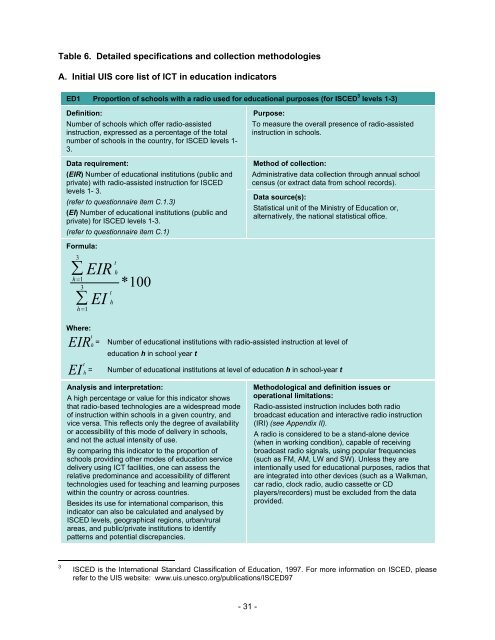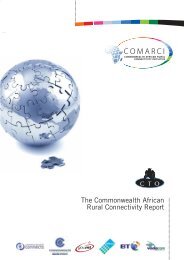Guide to measuring information and ... - unesdoc - Unesco
Guide to measuring information and ... - unesdoc - Unesco
Guide to measuring information and ... - unesdoc - Unesco
You also want an ePaper? Increase the reach of your titles
YUMPU automatically turns print PDFs into web optimized ePapers that Google loves.
Table 6. Detailed specifications <strong>and</strong> collection methodologies<br />
A. Initial UIS core list of ICT in education indica<strong>to</strong>rs<br />
ED1 Proportion of schools with a radio used for educational purposes (for ISCED 3 levels 1-3)<br />
Definition:<br />
Number of schools which offer radio-assisted<br />
instruction, expressed as a percentage of the <strong>to</strong>tal<br />
number of schools in the country, for ISCED levels 1-<br />
3.<br />
Data requirement:<br />
(EIR) Number of educational institutions (public <strong>and</strong><br />
private) with radio-assisted instruction for ISCED<br />
levels 1- 3.<br />
(refer <strong>to</strong> questionnaire item C.1.3)<br />
(EI) Number of educational institutions (public <strong>and</strong><br />
private) for ISCED levels 1-3.<br />
(refer <strong>to</strong> questionnaire item C.1)<br />
Formula:<br />
3<br />
EIR<br />
h 1<br />
3<br />
EI<br />
h 1<br />
t<br />
h<br />
t<br />
h<br />
* 100<br />
- 31 -<br />
Purpose:<br />
To measure the overall presence of radio-assisted<br />
instruction in schools.<br />
Method of collection:<br />
Administrative data collection through annual school<br />
census (or extract data from school records).<br />
Data source(s):<br />
Statistical unit of the Ministry of Education or,<br />
alternatively, the national statistical office.<br />
Where:<br />
EIR t<br />
h = Number of educational institutions with radio-assisted instruction at level of<br />
education h in school year t<br />
EI t<br />
h = Number of educational institutions at level of education h in school-year t<br />
Analysis <strong>and</strong> interpretation:<br />
A high percentage or value for this indica<strong>to</strong>r shows<br />
that radio-based technologies are a widespread mode<br />
of instruction within schools in a given country, <strong>and</strong><br />
vice versa. This reflects only the degree of availability<br />
or accessibility of this mode of delivery in schools,<br />
<strong>and</strong> not the actual intensity of use.<br />
By comparing this indica<strong>to</strong>r <strong>to</strong> the proportion of<br />
schools providing other modes of education service<br />
delivery using ICT facilities, one can assess the<br />
relative predominance <strong>and</strong> accessibility of different<br />
technologies used for teaching <strong>and</strong> learning purposes<br />
within the country or across countries.<br />
Besides its use for international comparison, this<br />
indica<strong>to</strong>r can also be calculated <strong>and</strong> analysed by<br />
ISCED levels, geographical regions, urban/rural<br />
areas, <strong>and</strong> public/private institutions <strong>to</strong> identify<br />
patterns <strong>and</strong> potential discrepancies.<br />
Methodological <strong>and</strong> definition issues or<br />
operational limitations:<br />
Radio-assisted instruction includes both radio<br />
broadcast education <strong>and</strong> interactive radio instruction<br />
(IRI) (see Appendix II).<br />
A radio is considered <strong>to</strong> be a st<strong>and</strong>-alone device<br />
(when in working condition), capable of receiving<br />
broadcast radio signals, using popular frequencies<br />
(such as FM, AM, LW <strong>and</strong> SW). Unless they are<br />
intentionally used for educational purposes, radios that<br />
are integrated in<strong>to</strong> other devices (such as a Walkman,<br />
car radio, clock radio, audio cassette or CD<br />
players/recorders) must be excluded from the data<br />
provided.<br />
3 ISCED is the International St<strong>and</strong>ard Classification of Education, 1997. For more <strong>information</strong> on ISCED, please<br />
refer <strong>to</strong> the UIS website: www.uis.unesco.org/publications/ISCED97
















